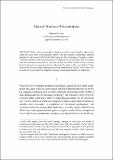Files in this item
Shared modes of presentation
Item metadata
| dc.contributor.author | Prosser, Simon | |
| dc.date.accessioned | 2020-10-08T23:34:54Z | |
| dc.date.available | 2020-10-08T23:34:54Z | |
| dc.date.issued | 2019-09 | |
| dc.identifier | 252182557 | |
| dc.identifier | 6a9f11bd-ac0c-42ad-80f1-778c398f8785 | |
| dc.identifier | 85054696678 | |
| dc.identifier | 000481816900003 | |
| dc.identifier.citation | Prosser , S 2019 , ' Shared modes of presentation ' , Mind & Language , vol. 34 , no. 4 , pp. 465-482 . https://doi.org/10.1111/mila.12219 | en |
| dc.identifier.issn | 0268-1064 | |
| dc.identifier.other | ORCID: /0000-0001-7444-2782/work/67525836 | |
| dc.identifier.uri | https://hdl.handle.net/10023/20749 | |
| dc.description.abstract | What is it for two people to think of something under the same mode of presentation (MOP)? This has seemed a difficult question for “atomistic” theories such as the Mental Files approach or the Language of Thought hypothesis. Here I propose a simple answer. I first argue that, by parallel with the synchronic intrapersonal case, the sharing of a MOP should involve epistemic transparency between the token thoughts of the two thinkers. I then explain how shared words help bring about this transparency. Finally, I show how the account can deal with MOPs expressed using demonstratives and indexicals. | |
| dc.format.extent | 266599 | |
| dc.language.iso | eng | |
| dc.relation.ispartof | Mind & Language | en |
| dc.subject | Concepts | en |
| dc.subject | Indexicals | en |
| dc.subject | Language of thought | en |
| dc.subject | Mental files | en |
| dc.subject | Modes of presentation | en |
| dc.subject | Shared thoughts | en |
| dc.subject | B Philosophy (General) | en |
| dc.subject | T-NDAS | en |
| dc.subject.lcc | B1 | en |
| dc.title | Shared modes of presentation | en |
| dc.type | Journal article | en |
| dc.contributor.institution | University of St Andrews. Philosophy | en |
| dc.identifier.doi | https://doi.org/10.1111/mila.12219 | |
| dc.description.status | Peer reviewed | en |
| dc.date.embargoedUntil | 2020-10-09 |
This item appears in the following Collection(s)
Items in the St Andrews Research Repository are protected by copyright, with all rights reserved, unless otherwise indicated.

